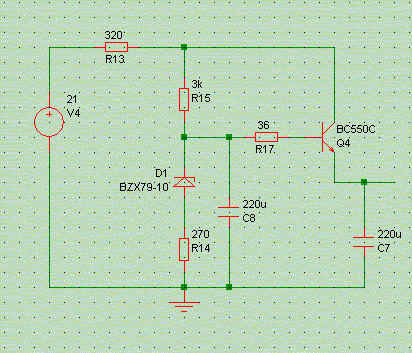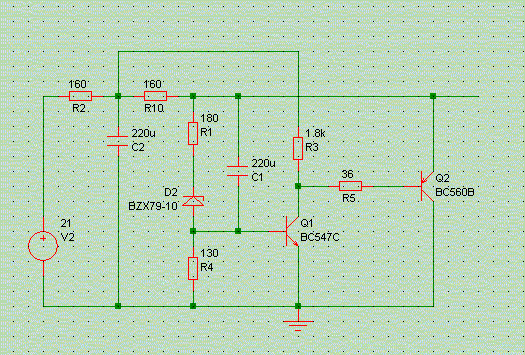Simple discrete shunt bipolar supply for OPA4134
I am interested in a simple but high quality +/-12V or +/-15V power supply to power an instrumentation amplifier in front of a LM3886.
The instrumentation amplifier will probably consist of a single OPA4134.
Initially I was going for a LM317 based regulated supply, however after reading this article:
Simple Voltage Regulators Part 1: Noise - [English]
I became interested in this circuit:

The low parts count, cheap components, and better than LM317 performance, make it a very attractive proposition.
This is also interesting:

But I am not sure about the BC560B transistor as I cannot source it easily. Would the BC560C work?
I am not very experienced in PS design so I have the following questions:
0) How does one calculate power/current requirements for the OPA4134?
1) Would either circuits have enough power to feed the OPA4134?
2) I believe either circuits generate 12v which should be enough for the OPA4134?
3) How do I turn the above circuits into a bipolar supply?
4) Input voltage for the PS is probably around +/-27V after the bridge rectifier as I am looking to use a centre-tapped 20V-0-20V transformer. Would the above circuits work with a +/-27V voltage?
Regards
Evan
I am interested in a simple but high quality +/-12V or +/-15V power supply to power an instrumentation amplifier in front of a LM3886.
The instrumentation amplifier will probably consist of a single OPA4134.
Initially I was going for a LM317 based regulated supply, however after reading this article:
Simple Voltage Regulators Part 1: Noise - [English]
I became interested in this circuit:

The low parts count, cheap components, and better than LM317 performance, make it a very attractive proposition.
This is also interesting:

But I am not sure about the BC560B transistor as I cannot source it easily. Would the BC560C work?
I am not very experienced in PS design so I have the following questions:
0) How does one calculate power/current requirements for the OPA4134?
1) Would either circuits have enough power to feed the OPA4134?
2) I believe either circuits generate 12v which should be enough for the OPA4134?
3) How do I turn the above circuits into a bipolar supply?
4) Input voltage for the PS is probably around +/-27V after the bridge rectifier as I am looking to use a centre-tapped 20V-0-20V transformer. Would the above circuits work with a +/-27V voltage?
Regards
Evan
Last edited:
power each from a separate 12Vac secondary.
Good point but would rather avoid having to use a separate traffo for the ps
Good point but would rather avoid having to use a separate traffo for the ps
You can use 1 traffo with 2 separate secondaries.
power each from a separate 12Vac secondary........................
Answered.You can use 1 traffo with 2 separate secondaries.
..
...and better than LM317 performance...
How can a simple zenner based regulator have better performance than LM317? that is quite impossible cus that zenner based regulator has a few drawbacks, like a poor load regulation ( verry poor ), thermal drift of the output, no shortcircuit and/or overload protection, and the cap on the bjt's base it's sort of useless, and it can do more wrong than help... a good regulator makes sure to eliminate or greatly reduce voltage ripple, LM317 has an option for verry low ripple, verry simple and safe to use, so again, a simple zenner based regulator can nevver have greater performance than LM317 with i would strongly suggest along with it's negative counterpart LM337.
I respectfully disagree!
What is it about LM317 that is inferior to zenner+ef? what could be unstable about it? LM317 has great load regulation, has no thermal issues, is well protected, loads of possible usses/configs... zenner+ef is verry simple to use, and it is sort of easyer to adapt it to high load current demands, that is why i think it is still used, i too use it sometimes when it's manny issues do not present a problem, but i never say that LM317 is inferior to justify it's use.
What is it about LM317 that is inferior to zenner+ef? what could be unstable about it? LM317 has great load regulation, has no thermal issues, is well protected, loads of possible usses/configs... zenner+ef is verry simple to use, and it is sort of easyer to adapt it to high load current demands, that is why i think it is still used, i too use it sometimes when it's manny issues do not present a problem, but i never say that LM317 is inferior to justify it's use.
If you look at the TNT AUDIO article in the first post they have found the LM317 based reg to give more noisy measurements and also sound noisier. To be honest I would probably not be able to hear any difference with my gear, but hey it's also a learning exercise.
You are right the LM317 can be improved with correct cap selection but I just find the simplicity of the zener concept irresistable.
There are ways to improve the zener setup further e.g. with a diode to counteract the thermal drift etc
You are right the LM317 can be improved with correct cap selection but I just find the simplicity of the zener concept irresistable.
There are ways to improve the zener setup further e.g. with a diode to counteract the thermal drift etc
Last edited:
As i sayd, sometimes zenner is ok to use, for example powering an OPA witch depending on the situation with a 1,3W zenner you can do verry well without any BJT helping it, just the zenner and a ballast resistor, but when considerable currents are involved ( 1A or more ) load regulation becomes an issue cus you have to use a EF witch takes it's Vbe from the output, that makes the output poor regulated, and LM317 has no souch issue, also when working with sort of high currents you need shortcircuit and/or overload prot cus you cannot hope to avoid any accident by any means just to safeguard the series pass transistor, ofcourse you can use a simple CCS but that complicates stuff and LM317 already has that protection, as for the so called noise, with LM317 you can connect a capacitor ( about 10u ) between the adj pin and ground, that takes care of almost any voltage ripple without any riscs, the cap multiplier of the BJT version presents some important safety issues for the BJT it's self. And i could go on and on...
Stability with respect to what parameter? Input voltage, load, temperature... else?I would contend that the 317 is "inferior" to a Zener + EF for stability.
Just because something is recommended by someone doesn't mean it is superior to everything else.If you look at the PASS site you will find that they use Z+EF for a number of their recommended PSUs. Why? Because they work well !
Also, steam traction engines did work extremely well; yet they have been abandoned at the beginning of the previous century, without apparent rational reason.
A well filtered (simple) zener regulator could do better than an IC, including the 317 on noise, but at the cost of everything else.
If performance is that important (all aspects), a custom mix of IC and discrete is the best solution, but I think it is rarely justified: modern audio amps have a good enough PSRR to accomodate moderate quality supplies without measurable impairment of the characteristics
In this case, no way: a LM317 is by far superior in this respectwith respect to step changes in either output current or input voltage.
Elvee,
I have not seen the Zener overshoot nor undershoot (glitch) when facing a step change.
I have not see a Zener oscillate when facing a step change.
That does not mean I have looked hard enough, but that I have not been the evidence.
There are numerous example of active regulators that do overshoot and oscillate and the 317 and similar are good examples of that lack of stability.
I have not seen the Zener overshoot nor undershoot (glitch) when facing a step change.
I have not see a Zener oscillate when facing a step change.
That does not mean I have looked hard enough, but that I have not been the evidence.
There are numerous example of active regulators that do overshoot and oscillate and the 317 and similar are good examples of that lack of stability.
- Status
- This old topic is closed. If you want to reopen this topic, contact a moderator using the "Report Post" button.
- Home
- Amplifiers
- Power Supplies
- Simple discrete shunt bipolar supply for opamp